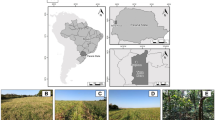Abstract
The study was undertaken to quantify the distribution of soil in different size fractions of water-stable aggregates, and organic C, total N, and total P associated with these aggregates, along a gradient of forest-savanna-cropland in the Indian dry tropics. The effect of residue (wheat straw) amendment under dryland cultivation was also investigated. Proportions of macroaggregates (>0.3 mm) were highest in the forest and lowest in the cropland soil and ranged from 58–66% in forest, to 55% in savanna and 25–36% in cropland. In contrast, microaggregates (<0.3 mm) were highest in cropland (64–75%), followed by savanna (45%), and lowest in forest soil (34–42%). Organic C, total N, and total P associated with the macroaggregates ranged from 6.52–29.56, to 0.62–2.44 and 0.06–0.15 g kg-1 soil, respectively, while the respective values in microaggregates were 4.99–22.11, 0.42–2.01, and 0.07–0.19 g kg-1 soil. This study indicates that land-use changes (conversion of forest into savanna and cropland) reduce the organic matter input to the soil and the proportion of macroaggregates. The application of wheat straw did not significantly influence the organic C and total N levels (P>0.05) in the short term, although the proportion of macroaggregates increased, indicating an improvement in soil structure. Thus soil degradation after conversion of natural systems to cropland can be arrested up to some extent by residue input to the soil.
Similar content being viewed by others
References
Chaney K, Swift RS (1984) The influence of organic matter on aggregate stability in some British soils. J Soil Sci 35: 223–230
Coleman DC, Hendrix PF (1988) Agroecosystems processes. In: Pomeroy LR, Alberts JJ (eds) Concepts of ecosystems ecology. Springer Verlag, New York, pp 149–170
Elliott ET (1986) Aggregate structure and carbon, nitrogen and phosphorus in native and cultivated soils. Soil Sci Soc Am J 50: 627–633
Elliott ET, Coleman DC (1988) Let the soil work for us. Ecol Bull (Stockholm) 39: 23–32
Gupta VVSR, Germida JJ (1988) Distribution of microbial biomass and its activity in different soil aggregate size classes as affected by cultivation. Soil Biol Biochem 20: 777–786
Harris RF, Chester G, Allen ON, Attoe OJ (1964) Mechanisms involved in soil aggregate stabilization by fungi and bacteria. Soil Sci Soc Am Proc 28: 529–532
Hendrix PF, Parmelee RW, Crossley DA Jr, Coleman DC, Odum EP, Groffman PM (1986) Detritus food webs and conventional and no-tillage agroecosystems. Bioscience 36: 374–380
Jackson ML (1958) Soil chemical analysis. Pentrice-Hall Inc, Englewood Cliffs, NJ
Kemper WD, Rosenau RC (1986) Aggregate stability and size distribution. In: Klute A (ed) Methods of soil analysis, Part I, 2nd edn. Agron Monogr 9. Am Soc Agron, Madison, Wis, pp 425–442
McGill WB, Cole CV (1981) Comparative aspects of cycling of organic C, N, S and P through soil organic matter. Geoderma 26: 267–286
Nelson DW, Sommers LE (1980) Total nitrogen analysis of soil and plant tissues. J Assoc Off Anal Chem 63: 770–780
Oades JM (1984) Soil organic matter and structural stability: Mechanisms and implications for management. Plant and Soil 76: 319–337
Pandey CB, Singh JS (1992) Rainfall and grazing effects on net primary productivity in a tropical savanna, India. Ecology 73: 2007–2021
Singh S (1993) Aggregate structure and carbon, nitrogen and phosphorus in forest, savanna and cultivated soils of a dry tropical region. PhD-thesis, Banaras Hindu University
Singh JS, Singh VK (1992) Phenology of seasonally dry tropical forest. Curr Sci 63: 684–688
Singh H, Singh KP (1993a) Effect of residue placement and chemical fertilizer on soil microbial biomass under tropical dryland cultivation. Biol Fertil Soils 16: 275–281
Singh L, Singh JS (1993b) Importance of short-lived components of a dry tropical forest for biomass production and nutrient cycling. J Veg Sci 4: 681–686
Singh JS, Raghubanshi AS, Singh RS, Srivastava SC (1989) Microbial biomass acts as a source of plant nutrients in dry tropical forest and savanna. Nature (London) 338: 499–500
Srivastava SC, Singh JS (1991) Microbial C, N and P in dry tropical forest soils: Effects of altemate land-uses and nutrient flux. Soil Biol Biochem 23: 117–124
Statistical Package for Social Sciences (1986) SPSS/PC for the IBM PC/XT/AT. SPSS, Chicago, III
Tiedje JM, Sexstone AJ, Parkin TB, Revsbech NP, Shelton DR (1984) Anaerobic processes in soil. In: Tinsley J, Darbyshire JF (eds) Biological processes and soil fertility, vol II. Martinus Nijhoff/Dr W Junk Publishers. The Hague, pp 197–212
Tisdall JM, Oades JM (1980) The effect of crop rotation on aggregation in a red-brown earth. Aust J Soil Res 18: 423–434
Tisdall JM, Oades JM (1982) Organic matter and water-stable aggregates in soils. J Soil Sci 33: 141–163
Walkely A (1947) A critical examination of a rapid method for determining organic carbon in soils. Effects of variations in digestion conditions and of inorganic soil constituents. Soil Sci 63: 251–264
Wardle DA (1992) A comparative assessment of factors which influence microbial biomass carbon and nitrogen levels in soils. Biol Rev 67: 321–358
Author information
Authors and Affiliations
Rights and permissions
About this article
Cite this article
Singh, S., Singh, J.S. Water-stable aggregates and associated organic matter in forest, savanna, and cropland soils of a seasonally dry tropical region, India. Biol Fert Soils 22, 76–82 (1996). https://doi.org/10.1007/BF00384436
Received:
Issue Date:
DOI: https://doi.org/10.1007/BF00384436




